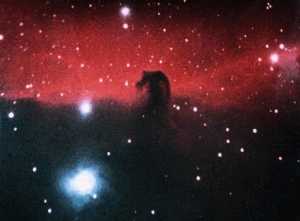

 |
 |
| The
dust in the ISM is made of tiny, irregularly shaped particles of
silicates (a type of mineral - similar to sand), carbon,
ice, and iron. The dust in the ISM can be detected
when it blocks or reflects light from nearby stars.
|
||||

In areas where the dust is thick, the light from nearby stars can be completely blocked - similar to the way very dark clouds block light from the sun. This picture (left) shows the Horsehead Nebula - the dark area in the center of the photograph (shaped like a horse's head) is a thick cloud of interstellar dust blocking the light. Thinner clouds of interstellar dust may dim the light passing through, without completely blocking it - similar to the way fog can dim light from the sun. This is known as extinction. |
||||
|
||||
|
So the ISM contains the seeds for brand new stars! New stars are formed when hot clouds of hydrogen in the ISM cool and collapse. In this lesson, you'll learn a little about how things cool off in general - and you might just be surprised by what you learn! Maybe you'll have your own ideas about how this strange stuff called the ISM cools off - and about how new stars form.
Finding the Beginnings of Stars Scientists know a lot about how stars end their long lives - they cool down and shrink, and may eventually explode and become supernovae. And they know a lot about how nearby stars and exploding supernovae can heat up the surrounding ISM. But what they are still puzzling over is how the ISM cools down to form new stars. This is the mystery that the CHIPS mission is trying to solve. The next few sections will give you a chance to explore some of the most important science behind the CHIPS mission, including density, heat, temperature, and cooling.
|
||||
|
|
||||
|
|